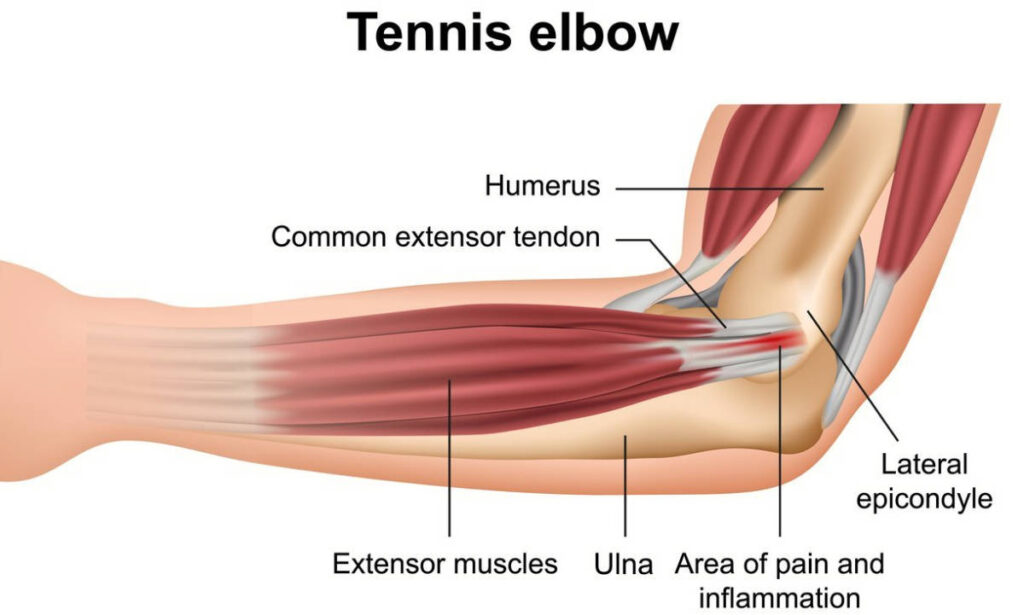Are you an avid tennis player that’s been sidelined due to elbow pain? If so, you’re not alone! Tennis elbow, or lateral epicondylitis, is a common condition that affects up to 50% of tennis players. It’s caused by overuse of the forearm muscles, leading to inflammation and pain.

Fortunately, with the right treatment and preventative measures, you can manage your pain and get back to the court. In this blog, we’ll discuss the causes and symptoms of tennis elbow, as well as how to manage the pain and get back to the court. So if you’re looking for tips on how to get back to your favorite sport, you’ve come to the right place!
Definition of Tennis Elbow
Tennis elbow is a painful condition caused by overuse of the elbow joint. The inflammation of the tendons and tendon sheaths results in pain and tenderness in the elbow area. Treatment for tennis elbow typically includes rest, ice, and anti-inflammatory medications to reduce swelling and pain. In severe cases, physical therapy and/or surgery may be necessary.
Symptoms of Tennis Elbow
There are several symptoms that can be associated with Tennis Elbow, the most common being a pain, and tenderness in the elbow area, which can sometimes radiate up the arm. Other symptoms may include decreased range of motion in the elbow, difficulty gripping objects with the hand, swelling, and redness in the elbow, especially if the pain is severe.
Causes of Tennis Elbow
There is no definitive answer to the question of why tennis elbow occurs. However, a number of factors are thought to contribute, including overuse, incorrect technique, and structural problems with the elbow joint. Overuse can be caused by repetitive motions or a heavy workload, while incorrect technique can involve incorrect arm positioning or faulty mechanics. Structural problems can include a misaligned joint, weak ligaments, or a torn tendon.
Overuse
There are many possible causes of tennis elbow, but the most common are overuse and inflammation. Overuse can come from playing too much tennis, too soon after an injury, or from using the wrong type of racket. Inflammation can come from a variety of factors, including overuse, genetics, and previous injuries.
To prevent tennis elbow, it is important to take regular breaks, use the right racket, and exercise regularly. If you experience pain, inflammation, or swelling in your elbow, see your doctor for a diagnosis and treatment plan.
Poor Technique
Tennis elbow is a common injury in the sport of tennis. Poor technique can cause the elbow to hyperextend and cause pain. The most common cause of tennis elbow is overuse, which can be caused by repetitive motions of the elbow. Other causes of tennis elbow include genetics and trauma. Treatment for tennis elbow typically includes rest and rehabilitation exercises.
Weak Grip Strength
Tennis elbow is a condition characterized by inflammation of the tendons in the elbow. It can be caused by a weak grip strength, which is often the result of repetitive use of the arm, such as playing the guitar or tennis. Weak grip strength can be exacerbated over time, leading to pain and discomfort. Taking regular breaks and using appropriate hand and arm support can help to reduce the risk of developing tennis elbow.
Prevention Strategies
Warm-up and Cool-down Exercises to prevent tennis elbow
Warm-up and Cool-down Exercises to prevent tennis elbow:
To prevent tennis elbow, it is important to do a warm-up and cool-down routine before and after playing tennis. The following exercises can help:
Warm-up:
Stretch your muscles before playing
When you play sports, it is important to stretch your muscles before and after the game. This will help to prevent injuries and keep your muscles flexible. It is also important to stretch your muscles before practice so that you are prepared for the physical demands of the sport.
Jog or walk around the court
If you are experiencing tennis elbow, it is important to take some time to move around the court in order to prevent the injury from worsening. Jogging or walking around the court can help to stretch the affected area, reduce inflammation, and improve the range of motion. Additionally, it can help to strengthen the muscles in the area, reducing the risk of further injury.
Do some light punching and kicking exercises
If you are experiencing tennis elbow, it is important to do some light punching and kicking exercises to prevent the condition from worsening and to increase your range of motion. Additionally, these exercises can help to reduce inflammation and prevent it from developing further.
Do a few repetitions of arm circles
Arm circles are an effective exercise for improving arm strength and preventing tennis elbow. Doing a few sets of arm circles every day will help to keep your arm muscles strong and healthy and can help to reduce the risk of tennis elbow.
Do some shoulder shrugs
Shoulder shrugs can help prevent tennis elbow. The motion stretches the muscles and tendons in your shoulder and helps to relieve the pain. To do a shoulder shrug, stand with your feet hip-width apart and your arms at your sides. Keeping your back straight, shrug your shoulders up to your ears. Hold for a few seconds, and then release. Repeat the motion several times.
Do some stretching exercises for your neck and back
Stretching is an essential part of maintaining healthy elbow joints, especially when it comes to preventing tennis elbow. Regular stretching exercises can help to elongate the muscles in the neck, back, and elbow area, thus relieving tension and reducing the risk of injury. Incorporate these exercises into your regular routine to ensure that your elbow remains healthy and strong.
Do some aerobic exercises
There are a few things that you can do to prevent tennis elbow. One of the best things that you can do is do some aerobic exercises. This will help to increase your heart rate and help prevent the buildup of tension in your muscles. Additionally, you should also make sure that you are stretching regularly. This will help to prevent the tension in your muscles from building up and causing you to experience pain.
Rest to prevent tennis elbow
Tennis elbow is a condition that results from repetitive use of the arm and hand in tennis or other racquet sports. Rest is the best treatment for tennis elbow, and it is important to follow the advice of a doctor. A doctor may prescribe pain medication or physical therapy to help relieve the pain and improve the function of the arm.
Vary Your Shots
If you’re a tennis player, you know that you need to vary your shots to avoid getting tennis elbow. One way to do this is to use different arm angles when hitting the ball. For example, if you’re hitting the ball with your backhand, try hitting it at a higher angle so that the ball goes further. Or, if you’re hitting the ball with your forehand, try hitting it at a lower angle so that the ball goes slower.
Improve Your Technique
If you are experiencing pain in your elbow, it is important to improve your technique. One way to avoid getting tennis elbow is to maintain good posture. When you are standing, try to keep your shoulders down and your head up. This will help to keep your elbow in a neutral position. Another way to avoid getting tennis elbow is to use a support sleeve. This sleeve helps to support your elbow and keep it in a neutral position. You can also read about the benefits of Glucosamine!
Strengthen Your Forearm Muscles
If you play tennis, you’re most likely aware of the risk of developing tennis elbow. The condition is caused by overuse of the forearm muscles and can be quite debilitating. To prevent this from happening, you can strengthen your forearm muscles. Here are three exercises you can do to strengthen your forearms:
The Hammer Curl
This is a classic forearm exercise that you can do with any weight you want. Place your palms flat on a bench and curl the weight up towards your shoulder blades.
The Farmer’s Walk
This exercise is similar to the hammer curl, but you will be walking instead of lifting the weight. Start by standing with your feet shoulder-width apart, and then walk your hands forward until your palms are facing forward. Keep your back straight and your shoulders pulled down.
The Seated Row
This is a more advanced exercise that will work your entire arm. Sit on the ground with your back against a bench, and then place your palms flat on the bench. Pull your shoulder blades down and back, and then lift your arms until they are parallel to the ground.
How to Manage Pain
There are a few ways to manage pain from having a tennis elbow. First, you can try to rest the elbow as much as possible. This means avoiding activities that aggravate the elbow, such as punching or throwing. You can also try to ice the elbow for 20 to 30 minutes after the activity to reduce inflammation and pain. If these measures do not work, you may need to see a doctor to have the elbow surgically repaired.
Rest
If you are experiencing tennis elbow, rest is key to help you recover. You may need to take a break from tennis altogether or reduce the intensity and duration of your workouts. Try to rest for at least two weeks and then begin gradually building up your activity level. If you experience continued pain, see your doctor for further evaluation.
Ice Cover or Cold Compress
Ice cover is one of the best ways to recover from tennis elbow. By applying ice to the affected area, you can reduce inflammation and pain. Over time, the ice will help to reduce inflammation and swelling. This will help to speed up the healing process.
Anti-inflammatory Medications
There are a few anti-inflammatory medications that can help you recover from tennis elbow. These medications can help to reduce the inflammation and pain that are often associated with this condition. Some of the most common anti-inflammatory medications used to treat tennis elbow include ibuprofen, naproxen, and aspirin. These medications can help to reduce the inflammation and pain that are often associated with this condition. Additionally, these medications can help to improve the function of the joint. Also, check this Glucosamine Chondroitin!
Physical Therapy Exercises
Physical Therapy exercises can help you recover from tennis elbow. It’s important to begin these exercises slowly and gradually to avoid aggravating the injury. Your physical therapist can provide you with specific exercises that are suitable for your condition and help you recover faster. With their guidance and advice, you can make steady progress toward full recovery.
Returning to the Court
Gradual Increase in Intensity
If you experience tennis elbow, it is important to gradually increase the intensity of your workouts to prevent another flare-up. This will help you strengthen and stretch the affected area, which will reduce inflammation and pain. Additionally, be sure to take breaks between exercises to allow your muscles to rest and recover. Doing so will allow you to build up strength and keep your elbow healthy.
Utilize Proper Technique
If you suffer from tennis elbow, it is important to use proper technique to prevent it from happening again. Try these tips to help you prevent tennis elbow from happening again:
- Warm up properly before playing. Start with a light jog or walk before warming up for the more vigorous activity.
- Stay hydrated. Drink plenty of fluids throughout the day to help keep your muscles and joints hydrated.
- Avoid using excessive force. Use moderate pressure when swinging the racket.
- Use a tennis ball that is the right size for your racket. A larger ball will cause more stress on your elbow, while a smaller ball will be harder to control.
- Eliminate stressors. If you can, try to avoid situations or activities that cause stress. This includes working out too hard, playing in high humidity, or playing with a partner who is aggressive.
- Take care of your elbow. Keep your elbow clean and dry. Apply a cold pack of ice to your elbow for 10 to 15 minutes after playing to reduce inflammation.
Wear a Supportive Brace or Strap
If you experience tennis elbow, it is important to wear a supportive brace or strap to prevent it from happening again. Wearing a brace or strap can help to reduce the inflammation and pain that can accompany tennis elbow. If you experience any pain or swelling in your elbow, it is important to seek medical attention as soon as possible.
Conclusion
Tennis Elbow can be a very painful and debilitating injury, but with the proper treatment and care, it doesn’t have to keep you from playing the sport you love. By taking rest, icing the area, and using the RICE method for recovery, you can reduce the pain and inflammation. Additionally, using an elbow brace, taking anti-inflammatory medications, and doing strengthening and stretching exercises can help you get back on the court faster.
So don’t let the Tennis Elbow stop you from playing the sport you love. With the right treatment and care, you can manage the pain and get back out there in no time. If you find these blogs helpful, please share this with your loved ones and friends. You are also welcome to visit our other related blog for more tips and recommendations.


